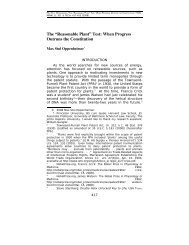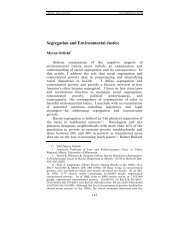An Organizational Approach to the Design of Patent Law
An Organizational Approach to the Design of Patent Law
An Organizational Approach to the Design of Patent Law
You also want an ePaper? Increase the reach of your titles
YUMPU automatically turns print PDFs into web optimized ePapers that Google loves.
6 VERTINSKY FINAL_JAD (DO NOT DELETE) 2/27/2012 2:20 PM<br />
262 MINN. J. L. SCI. & TECH. [Vol. 13:1<br />
User innova<strong>to</strong>r communities are <strong>of</strong>ten characterized by a “free<br />
revealing” <strong>of</strong> <strong>the</strong>ir innovations with o<strong>the</strong>rs in response <strong>to</strong> private<br />
benefits that <strong>the</strong>y can obtain as a result, such as recognition,<br />
adoption <strong>of</strong> certain generally available technologies, or <strong>the</strong><br />
exchange <strong>of</strong> contributions from o<strong>the</strong>rs. 220 The informal rules<br />
which sustain free revealing may override, or come in<strong>to</strong> conflict<br />
with, formal rules <strong>of</strong> ownership over <strong>the</strong> information. In “open<br />
source” s<strong>of</strong>tware development projects, contribu<strong>to</strong>rs commit <strong>to</strong><br />
make <strong>the</strong>ir contributions available for duplication and use<br />
without charge. 221 <strong>Patent</strong>s may serve <strong>to</strong> undermine certain<br />
types <strong>of</strong> innovation structures by interfering with norms <strong>of</strong> information<br />
sharing. Alternatively, <strong>the</strong>y may streng<strong>the</strong>n <strong>the</strong> systems<br />
by creating mechanisms for enforcing <strong>the</strong> sharing <strong>of</strong> information,<br />
like through open source licensing. As an example,<br />
<strong>the</strong> open source model <strong>of</strong> s<strong>of</strong>tware has managed <strong>to</strong> co-exist with<br />
proprietary s<strong>of</strong>tware ownership and, indeed, has utilized intellectual<br />
property rights <strong>to</strong> formalize and perpetuate <strong>the</strong> open<br />
source model through license agreements such as <strong>the</strong> General<br />
Public License.<br />
Focusing on levels three and four <strong>of</strong> <strong>the</strong> framework, <strong>the</strong> existing<br />
literature suggests that <strong>the</strong> connection between patents<br />
and market structure is critical. 222 Industry-specific studies,<br />
and applications <strong>of</strong> industrial organization <strong>to</strong> <strong>the</strong> study <strong>of</strong> patents<br />
and innovation—in particular market structures—move<br />
in <strong>the</strong> right direction. Examples include <strong>the</strong> study <strong>of</strong> industries<br />
where standard setting is important and where technological<br />
progress is characterized by incremental, cumulative innovation.<br />
223 The organizational approach <strong>to</strong> innovation connects in-<br />
220. See Eric von Hippel, Innovation by User Communities: Learning from<br />
Open-Source S<strong>of</strong>tware, MIT SLOAN MGMT. REV. 84, 85 (2001).<br />
221. See, e.g., James Bessen, What Good is Free S<strong>of</strong>tware?, in<br />
GOVERNMENT POLICY TOWARD OPEN SOURCE SOFTWARE 14–18 (Robert W.<br />
Hahn ed., 2002).<br />
222. Attention is increasingly directed <strong>to</strong>wards <strong>the</strong>ories <strong>of</strong> patents and<br />
market structure, spurred by <strong>the</strong> work <strong>of</strong> Lemley, Merges, Barnett, and o<strong>the</strong>rs.<br />
Overall patent scholars have been much slower than anti-trust scholars <strong>to</strong><br />
turn <strong>the</strong>ir attention <strong>to</strong> issues <strong>of</strong> market structure and <strong>the</strong> organization <strong>of</strong> innovation.<br />
223. E.g., Bronwyn H. Hall & Rosemary Ham Ziedonis, The <strong>Patent</strong> Paradox<br />
Revisited: <strong>An</strong> Empirical Study <strong>of</strong> <strong>Patent</strong>ing in <strong>the</strong> U.S. Semiconduc<strong>to</strong>r Industry,<br />
1979-1995, 32 RAND J. ECON. 101, 102 (2001) (conducting interviews <strong>of</strong><br />
industry representatives and analyzing <strong>the</strong> industries patenting behavior);<br />
Burk & Lemley, Policy Levers in <strong>Patent</strong> Policy, supra note 22, at 1619–24 (citing<br />
examples from different industries).






